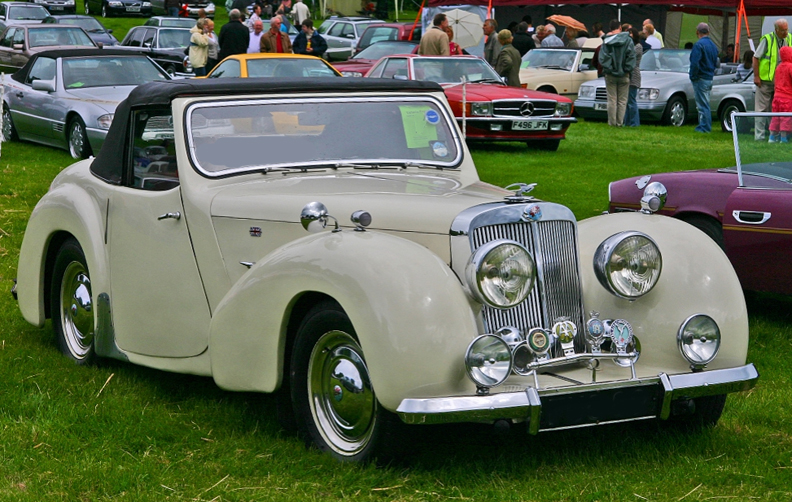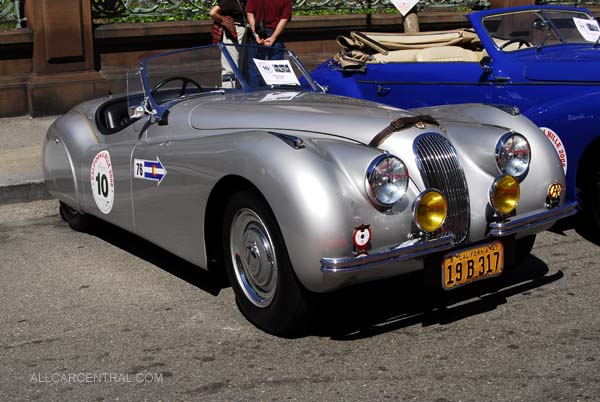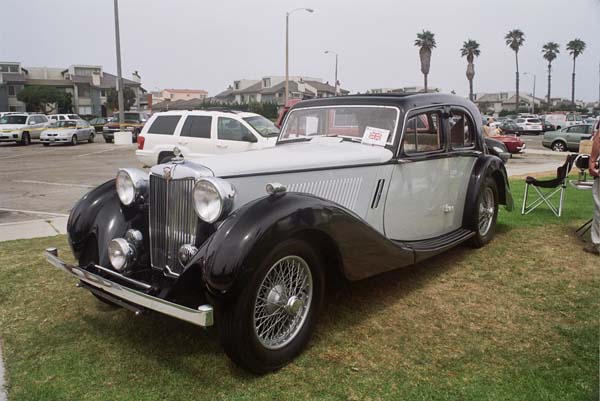1946 Triumph 1800 Roadster
Submitted by Rick Feibusch

The Standard Motor Company of the UK were the principle suppliers of engines to the British Motor Industry including such names as Jaguar, Talbot, Hillman etc from 1919 through to 1939 The then Chief Executive Officer, Sir John Black, wanted to produce a luxury vehicle that could compete in the luxury British market, so in 1939 he purchased the once successful but now bankrupt Triumph Motor Company, not to be confused with the post war sports cars made under the same name.
The pre-war Triumph Company made hand built luxury cars and Motor Cycles but the effect of the depression eventually forced the company out of business. Sir John had to wait until the end of the Second World War before he could revitalize the Triumph Company. (The Motor Cycle business had been sold in 1938 before the Standard purchase). Standard did produce a series popular low cost private family vehicles but the company desire was to also enter into the high price market. Utilizing the prewar SS Jaguar engine that belonged to the Standard Motor Company they produced the Triumph GT 1800 The car was first introduced at the 1947 London, Earls Court Motor Show, the first post war show in Europe.
It was not an outstanding success, primarily because of its poor performance. Elegant in every sense of the word it took at least one minute to reach 65 MPH due to its weight and the low power performance of the SS Jaguar engine which was not designed to pull a 3.400 pound motor car! With poor sales and a high purchase cost the company decided in 1949 to change the power by the use of the new Vanguard two liter engine that had been designed for the Ferguson tractor and the Standard Vanguard sedan that was a successful export to North America in the 1950s.This pushed the performance up to 70 MPH, on a flat surface! Assuming the wind was behind the car! That same year Jaguar, who were now producing their own engines, exhibited the XK 120 at the Earls Court Motor Show and stole the thunder.
1949 Jaguar XK 120

They sold their entire production for 1950 during the ten days that the Motor show was open. No other expensive touring/sports vehicle stood a chance against the new Jaguar. The Triumph 2000 was withdrawn from production in the spring of 1950, and joined the ranks of the almost made it, but now forgotten brigade.
In total about 1,980 were produced, all hand made with expensive leather interiors incorporating a hand built walnut dash etc. Until a few years ago i owned one of these cars not quite a sports machine but it always got a few nice comments when it was parked.
Geoff Wheatley
A bit more from Geoff Wheatley on this subjct:
The Standard Motor Company was the third largest in Britain during the 1930s. Its fame rested with the production of engines that it supplied to various car manufacturers both in the UK and Europe. One of its customers was the small SS Jaguar Motor Company created by William Lyons that produced the successful SS Jaguar range between 1934 and 1939.
Lyons did not have the capital to produce his own engines so he, like many other British manufacturers turned to the Standard Motor Company who in turn created a high performance engine specially designed for Jaguar. As was the custom at that time Jaguar had the rights to the trade mark but Standard retained the patent for this engine. Apart from Rolls Royce, Morris and Austin, virtually every other car manufacturer purchased their engines from private manufacturers both in the UK and the USA. The CEO of Standard was John Black, later to become Sir John Black for his services to British industry. Black was the type of man that you never corrected, or disagreed with, standing well over six foot in his stocking feet he controlled the Standard operation with a iron fist, some say two! It was his way, or the doorway as far as the Standard Motor Company was concerned. He was the management team, design team, production team and sales team, not that the word team meant anything to Sir John!
The Standard Motor Company Board of Directors would have been better served to have stayed at home during a Board Meeting and simply collected their fees by mail rather than attending with Sir John in the chair! His desire for Standard was to move his rather bland but reliable range of motor vehicles into the luxury market. He certainly resented the success of Jaguar and even tried to purchase the company from William Lyons without success in its early years.
The Triumph Motor Company was a highly specialized manufacturer producing a classic range of quality vehicles and at the same time operating a very successful Motor Cycle Company. Dennis Healey, later to be known as the creator and producer of the Healey Sports Car was the chief designer for Triumph and a keen international competitor. The beautiful Triumph Dolomite won the 1936 European Alpine Rally with Healey behind the wheel and went on to sweep the international circuit. However, by 1937 the rosy world for Triumph cars was quickly ending, the depression had severely reduced the market for quality cars and Triumph had been forced to sell its motor cycle company to meet operating costs. The SS Jaguar became a serious rival to the Triumph Company both in price and performance.
MG SA Saloon 1936
Submitted by Rick Feibusch

When MG introduced the “WA” range of luxury sedans priced well below the cheapest Triumph, the future looked doubtful. By early 1939 it was obvious that Triumph was in serious trouble with both of its production factories on a two day week and sales falling through the floor.
Sir John Black saw this as his chance to enter the prestige car market on the cheap and snapped up Triumph for less than the estimated value of the land that the company owned. However, he did not anticipate the outbreak of war in the fall of 1939 when he had to turn these factories over to war work for the next five years. Like the USA all production of private cars ceased one day after war was declared. The needs of the government were the order of the day. War material flowed out of British industry at a rate never achieved before. Tanks from MG. Guns from Austin, Trucks from Morris and to give some idea of the production challenge the famous Mosquito fighter bomber was produced by Standard in one of the Triumph factories.
By 1944 it was obvious that the war was going to end in favor of the Allies.
Sir John Black wanted to be one of the first manufacturers to have a new modern and attractive range of post war vehicles to offer the public. He set aside a small design team to work on this objective but as expected he was the real design team and the others simply people who tried to turn his ideas into reality. The new range of quality cars would carry the name Standard Triumph to please the shareholders and to keep the Standard dealers happy. The beautiful pre-war Dolomite featured two small seats in the rear section, known at the time as Dicky Seats or Rumble Seats here in the USA. Even in 1936 these were considered a little out of date but with the classic lines of the Dolomite it was acceptable. However by 1944/45 such a feature was certainly antique and the senior designer for Standard who had been a loyal employee for many years pointed this out to Sir John when he demanded that one of the new cars should feature a reproduction of the Dolomite seats. This senior designer was removed from the team, his desk was cleared and he never set foot in the company again! This did not encourage any of the other team members to make recommendations or adverse comments about the leaders ideas.
As Standard had the patent for the prewar SS Jaguar engine Sir John decided that he would use this power unit for his new post war vehicles, however as the capacity was under two liters and his Triumph sedan weighed over 2,800 pounds he decided that the unit would be confined to the sports model, soon to be known as the Triumph 1800 Sports GT. Yes it did feature the two rear seats in company with a solid walnut dash and a four speed forward column gear change with reverse included if you could ever find it. Eight inch headlights of course, with a soft expensive leather interior. An counter lever top with a balanced chrome frame completed the picture. When the 1800 GT Sports was shown to the Motor Press in the fall of 1947 the best comment that could be recorded was “Who would want such a vehicle?” The others were less complimentary. However, the British public had been starved for six long years and would buy anything with four wheels and an engine. It was much the same in the USA as illustrated by some of the cars produced between 1946 and 1949!
The main complaint was the lack of power for the Triumph 1800. GT . With the wind behind you it might touch 60 mph but there was no snappy gear change or wild wind in your hair! To call it a sports vehicle was an insult to the name, even the prewar designed MGTC selling for half the price could leave the 1800 standing. Sir John had signed a contract with Ferguson to make their post war tractors after Ford lost the contract. This required a new engine and Standard, true to its real calling, produced the famous Vanguard two liter OHV power unit. This was fitted to the Triumph GT and promoted as the new Triumph 2000 Super Sports at the 1949 Earls Court Motor show. However, Jaguar also had a new vehicle to present to the public, the incredible XK120. This car simply took the motor world by storm and before the ten day show was over two years production had been sold in forward orders by the Jaguar team.
Triumph never stood a chance and by 1949 the 2000 Super Sports was withdrawn in company with most of the others cars that Sir John had designed and pushed through the factories. Standard continued production with the successful Standard Vanguard Sedan that sold well this side of the Atlantic while Triumph was allowed to operate as a separate company producing the successful TR range of sports cars. Sir John stepped down as CEO and faded into history.
In his biography he indicated that he was never aware that Jaguar had developed their own engine for the XK120 or that such an attractive car could emerge from such a small company! In short; Sir John always saw the big picture especially when it was his own!
Geoff Wheatley




BACK TO TOP